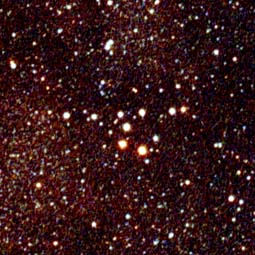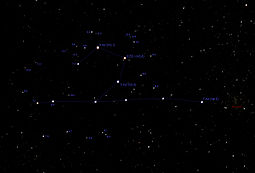
Brocchi's Cluster
Encyclopedia

Constellation
In modern astronomy, a constellation is an internationally defined area of the celestial sphere. These areas are grouped around asterisms, patterns formed by prominent stars within apparent proximity to one another on Earth's night sky....
Vulpecula
Vulpecula
Vulpecula is a faint constellation in the northern sky. Its name is Latin for "little fox", although it is commonly known simply as the fox. It was identified in the seventeenth century, and is located in the middle of the Summer Triangle .-Stars:There are no stars brighter than 4th magnitude in...
near the border with Sagitta
Sagitta
Sagitta is a constellation. Its name is Latin for "arrow", and it should not be confused with the larger constellation Sagittarius, the archer. Although ancient, it is insignificant, for it has no star brighter than the 4th magnitude and is the third smallest of all constellations...
. Collinder
Collinder catalog
In astronomy, the Collinder catalog is a catalog of open clusters by Swedish astronomer Per Collinder. It was published in 1931 as an appendix to Collinder's paper On structural properties of open galactic clusters and their spatial distribution. Catalog objects may be denoted as Col + catalog...
399 is known as Al Sufi's Cluster or Brocchi's Cluster. The brighter members of this star cluster form an asterism
Asterism (astronomy)
In astronomy, an asterism is a pattern of stars recognized on Earth's night sky. It may form part of an official constellation, or be composed of stars from more than one. Like constellations, asterisms are in most cases composed of stars which, while they are visible in the same general direction,...
also known as the Coathanger.
History
Before 964, it was first discovered by the Persian astronomerAstronomy
Astronomy is a natural science that deals with the study of celestial objects and phenomena that originate outside the atmosphere of Earth...
Al Sufi, and described in his Book of Fixed Stars
Book of Fixed Stars
The Book of Fixed Stars is an astronomical text written by Abd al-Rahman al-Sufi around 964. The book was written in Arabic, although the author himself was Persian...
in 964.
In the 17th century, it was independently rediscovered by Italian astronomer Hodierna.
In the 1920s, Brocchi, an amateur astronomer and chart maker for the American Association of Variable Star Observers
American Association of Variable Star Observers
Since its founding in 1911, the American Association of Variable Star Observers has coordinated, collected, evaluated, analyzed, published, and archived variable star observations made largely by amateur astronomers and makes the records available to professional astronomers, researchers, and...
(AAVSO), created a map of this object for use in calibrating photometers.
In 1931, Swedish astronomer Collinder
Per Collinder
Per Collinder was a Swedish astronomer. He is known for a catalog of open clusters that he published in 1931, which is today known as the Collinder catalog. He has written two books History of navigation and Worlds in orbit.He was married twice, and his first wife gave him four children....
listed it in his catalogue of open clusters
Collinder catalog
In astronomy, the Collinder catalog is a catalog of open clusters by Swedish astronomer Per Collinder. It was published in 1931 as an appendix to Collinder's paper On structural properties of open galactic clusters and their spatial distribution. Catalog objects may be denoted as Col + catalog...
.
Status
The status of this group as a star cluster has changed in recent years. The group was considered to be a cluster for most of the 20th century. Looking at a variety of criteria, however, a study in 1970 concluded that only 6 of the brightest stars formed an actual cluster. Several independent studies since 1998 have now determined that this object is not a true cluster at all, but rather just a chance alignment of stars. These recent studies have generally based their findings on improved measurements of parallaxParallax
Parallax is a displacement or difference in the apparent position of an object viewed along two different lines of sight, and is measured by the angle or semi-angle of inclination between those two lines. The term is derived from the Greek παράλλαξις , meaning "alteration"...
and proper motion
Proper motion
The proper motion of a star is its angular change in position over time as seen from the center of mass of the solar system. It is measured in seconds of arc per year, arcsec/yr, where 3600 arcseconds equal one degree. This contrasts with radial velocity, which is the time rate of change in...
provided by the Hipparcos
Hipparcos
Hipparcos was a scientific mission of the European Space Agency , launched in 1989 and operated between 1989 and 1993. It was the first space experiment devoted to precision astrometry, the accurate measurement of the positions of celestial objects on the sky...
satellite which were first published in 1997.
The "Coathanger"


Apparent magnitude
The apparent magnitude of a celestial body is a measure of its brightness as seen by an observer on Earth, adjusted to the value it would have in the absence of the atmosphere...
which form the conspicuous "coathanger", a straight line of 6 stars with a "hook" of 4 stars on the south side. An additional 30 or so fainter stars are sometimes considered to be associated as well.
Under a dark sky, Collinder 399 can be seen with the naked eye as an unresolved patch of light; binoculars or a telescope at very low power are usually needed in order to view the "coathanger" asterism. It is best found by slowly sweeping across the Milky Way
Milky Way
The Milky Way is the galaxy that contains the Solar System. This name derives from its appearance as a dim un-resolved "milky" glowing band arching across the night sky...
along an imaginary line from the bright star Altair toward the even brighter star Vega
Vega
Vega is the brightest star in the constellation Lyra, the fifth brightest star in the night sky and the second brightest star in the northern celestial hemisphere, after Arcturus...
. About one third of the way toward Vega, the Coathanger should be spotted easily against a darker region of the Milky Way. The asterism is best seen in July-August and north of 20° north latitude it is displayed upside down (as in the picture top right of this page) when it is at its highest point. South of this latitude it is shown upright as the 'hanger' is south of the line of 6 stars.
The asterism and its immediate surroundings are a useful gauge for determining the faintest stars visible in a small telescope as there are a wide range of stellar magnitudes within the cluster easily viewed in one small location of the sky.
Catalogue Data
- Name: Collinder 399
- Right AscensionRight ascensionRight ascension is the astronomical term for one of the two coordinates of a point on the celestial sphere when using the equatorial coordinate system. The other coordinate is the declination.-Explanation:...
: 19h 25m 24s - DeclinationDeclinationIn astronomy, declination is one of the two coordinates of the equatorial coordinate system, the other being either right ascension or hour angle. Declination in astronomy is comparable to geographic latitude, but projected onto the celestial sphere. Declination is measured in degrees north and...
: +20°11′00″ - MagnitudeMagnitude (astronomy)Magnitude is the logarithmic measure of the brightness of an object, in astronomy, measured in a specific wavelength or passband, usually in optical or near-infrared wavelengths.-Background:...
: 3.6m (visual) - Diameter: ~60'
- Magnitude of Brightest Star: 5.19m (visual)

